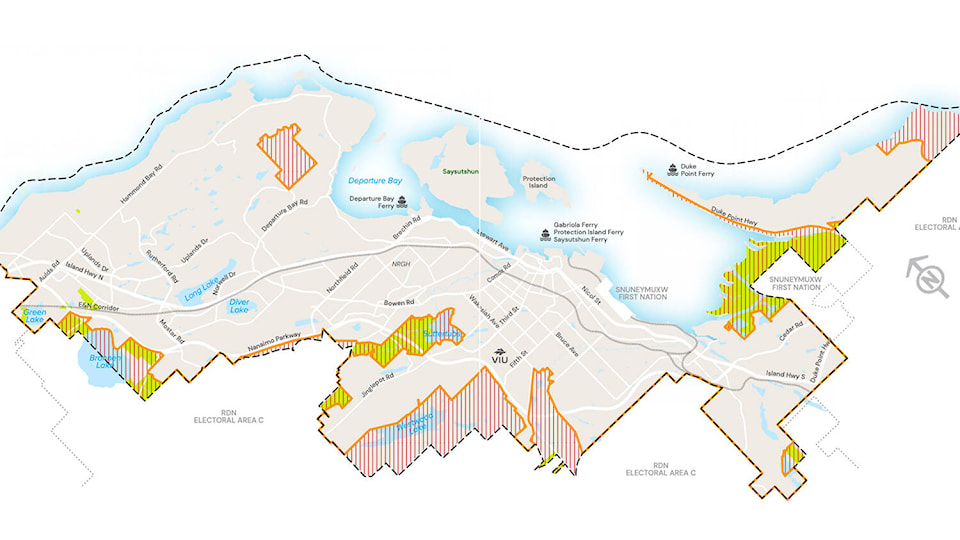Nanaimo’s next city plan envisions growth along a series of urban hubs, but a business-minded group in the region is asking for growth around the city’s edges, too.
Mark Holland, president of Holland Planning Innovations, spoke to city council May 30 on behalf of the Mid Island Business Initiative and urged the city to consider expanding its boundaries in order to build more housing.
Mike Delves, MIBI director, said the lack of available and affordable real estate is proving to be an impediment to economic activity in the region.
Holland pointed to the current housing crunch and said with Nanaimo’s anticipated growth, there isn’t enough developable land to keep up with demand, even factoring in the huge Green Thumb-Bowers District and Sandstone projects.
“Both of those combined will barely support five years of growth here in the city,” Holland said. “If we could wave a magic wand and they were both finished tomorrow morning, we would be out of capacity within five or six years.”
He said that assuming 1,600-1,800 new residents each year in Nanaimo, that means 800-900 new units need to be built each year just to keep up, let alone build excess inventory to alleviate the housing crisis. One of the problems he identified is that some of the land the city considers developable is currently parking lots, and he said the development industry rarely develops parking lots due to high cost of constructing replacement underground parking.
“The growth areas in your current OCP are not necessarily aligned with the open land and so the challenge that we face now is the majority of the growth needs to go in infill,” Holland said.
There are areas throughout the city suitable for infill development, he said, mentioning Metral Drive, Uplands Drive, Bowen Road, Highland Boulevard and “a big opportunity to do more” in Harewood as some examples. However, he noted that the time spent in permitting infill projects, combined with the fact that it displaces residents in the interim, makes it a slow process to create net housing.
Holland said many of the city’s boundaries are “historical and arbitrary” and said there is already public works servicing right to the city boundaries in many parts of Nanaimo. He asked the city to include “special study areas” in the city plan and initiate discussions with the Regional District of Nanaimo to bring in additional land.
He argued that “sprawl is not an actual location, it’s a land-use pattern” and said greenfield land can be developed in alignment with the city plan by creating “complete neighbourhoods,” with the corridors to and from those neighbourhoods becoming de facto town centres.
Councillors weren’t convinced by the presentation, as Coun. Tyler Brown suggested he agreed with Holland’s premises about the housing crisis but not his conclusions around greenfield development. Brown noted that the city has seen an average of close to 1,100 new residential units being permitted per year the past five years, and more than 800 already this year.
Coun. Don Bonner said other cities have been able to densify and he thinks Nanaimo should, too.
“I really am not keen on the idea of expanding our boundaries when we have such a low density of population,” he said. “I fully understand it’s much easier and cheaper to develop empty space than it is to redevelop existing houses, but I think that’s what we need to do.”
READ ALSO: Council sends Nanaimo’s city plan to public hearing
Dale Lindsay, the city’s general manager of development services, told the News Bulletin that the city thinks there is capacity, within the city plan, to be able to keep up with housing needs. He said the city has been seeing a “significant” number of permit applications in the urban centres where growth is desired, and mentioned that owners of the city’s “two major malls” are exploring mixed-use development, including residential units, in the short term.
“All the information we have right now is that there is sufficient land to accommodate growth in the city,” Lindsay said. “[The plan] does acknowledge that if we want to continue building low-density, single-family neighbourhoods, that in the lifetime of the plan, the city will eventually run out of lands to do that.”
The city plan does call for a review of the city boundaries “to identify potential adjustments to reflect current land use and future needs” and for consideration of regular revisions to the urban containment boundary.
Lindsay said changing the city boundaries requires the approval of the electorate and an amendment to the regional growth strategy, and the city would need to study if potential land additions make sense from a servicing, transportation and asset management standpoint. Lindsay pointed out that boundary rationalization could mean expansion or contraction, and it would be up to a city council to decide where a city boundary review would fit among any number of civic priorities.
“I don’t think there’s an urgent need to do that, and [we] should emphasize it’s not a quick and easy process to change the city boundary,” he said.
READ ALSO: Nanaimo city council presented with ‘shocking’ housing affordability concerns
READ ALSO: City of Nanaimo re-examines affordable housing strategy as low rental vacancy rates persist
READ ALSO: City of Nanaimo’s population reaches 100,000
editor@nanaimobulletin.com
Like us on Facebook and follow us on Twitter
